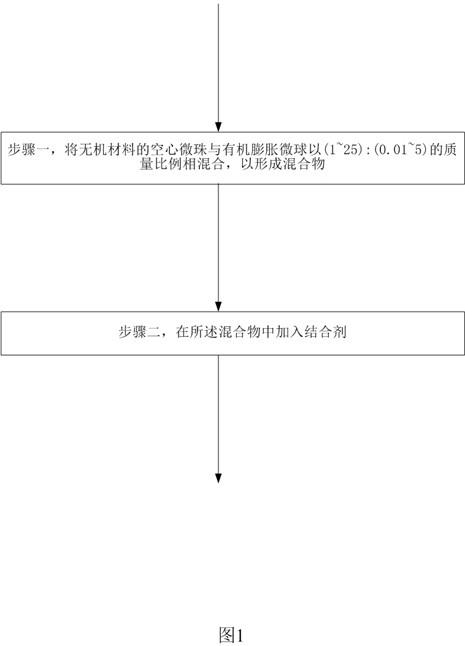Thermal insulation material with vacuum-like structure and preparation method thereof
A thermal insulation material and vacuum technology, applied in the field of thermal insulation materials, can solve the problems of difficulty in obtaining a vacuum structure and difficulty in maintaining a stable vacuum state for a long time, and achieve the effects of low thermal conductivity, high-efficiency thermal insulation and sound insulation materials, and high acoustic resistance.
- Summary
- Abstract
- Description
- Claims
- Application Information
AI Technical Summary
Problems solved by technology
Method used
Image
Examples
preparation example Construction
[0017] Now refer to figure 1 , which shows a method for preparing an insulating material with a vacuum-like structure according to an embodiment of the present invention. As shown in the figure, the method includes the following steps:
[0018] Step 1, mixing hollow microspheres of inorganic materials with organic expanded microspheres in a mass ratio of (1~25):(0.01~5) to form a mixture; and
[0019] Step 2, adding a binding agent into the mixture.
[0020] In some embodiments, the hollow microspheres of inorganic materials are vitrified hollow microspheres or ceramic hollow microspheres, and the expanded organic microspheres are expanded hollow microspheres of organic polymers.
[0021] In some embodiments, the organic expanded microspheres are hollow shell spherical powder materials made of acrylic polymers, epoxy polymers, melamine or polyimide polymer materials by physical or chemical methods, For example, organic high molecular polymer expanded hollow microspheres suc...
Embodiment 1
[0046] Embodiment one, thermal insulation coating
[0047] 1. Use vitrified hollow microspheres or ceramic hollow microspheres (A) and organic expanded microspheres (B) to mix in a mixer, the mixing mass ratio is: A:B = (1~25):(0.01~5 ), thus forming C. Specifically, the mixing mass ratio may be, for example, A:B=5:2, or 11:2.
[0048] 2. Add a binder emulsion with a mass fraction ratio of 1:1 to C; the thermal insulation coating can be obtained by stirring and aging. The emulsion can be, for example, a polymer copolymer emulsion such as an acrylate copolymer emulsion or a polyurethane copolymer emulsion.
Embodiment 2
[0049] Embodiment 2. Thermal insulation (sound insulation) inorganic board
[0050] 1. Use vitrified hollow microspheres or ceramic hollow microspheres (A) and organic expanded microspheres (B) to mix in a mixer, the mixing mass ratio is: A:B = (1~25):(0.01~5 ), thus forming C. Specifically, the mixing mass ratio may be, for example, A:B=5:2, or 11:2.
[0051] 2. Mix C and calcium silicate powder (D) according to the ratio of mass ratio C:D=3:1, then add 20% left and right deionized water (you can also add appropriate amount of fiber), stir well and then age After 40 minutes, a paste (E) with a viscosity of more than 20000 mPa·s was obtained. The 20% deionized water refers to the ratio of deionized water to C+D+deionized water. The appropriate amount of fiber may be, for example, 1-5% fiber.
[0052] 3. Fill the mold with E, heat-press it with a hot press at a temperature of 110-180°C and a pressure of 30 MPa, and then dry it in a drying tunnel kiln to make a thermal insul...
PUM
| Property | Measurement | Unit |
|---|---|---|
| density | aaaaa | aaaaa |
| viscosity | aaaaa | aaaaa |
| viscosity | aaaaa | aaaaa |
Abstract
Description
Claims
Application Information
 Login to View More
Login to View More - R&D
- Intellectual Property
- Life Sciences
- Materials
- Tech Scout
- Unparalleled Data Quality
- Higher Quality Content
- 60% Fewer Hallucinations
Browse by: Latest US Patents, China's latest patents, Technical Efficacy Thesaurus, Application Domain, Technology Topic, Popular Technical Reports.
© 2025 PatSnap. All rights reserved.Legal|Privacy policy|Modern Slavery Act Transparency Statement|Sitemap|About US| Contact US: help@patsnap.com

